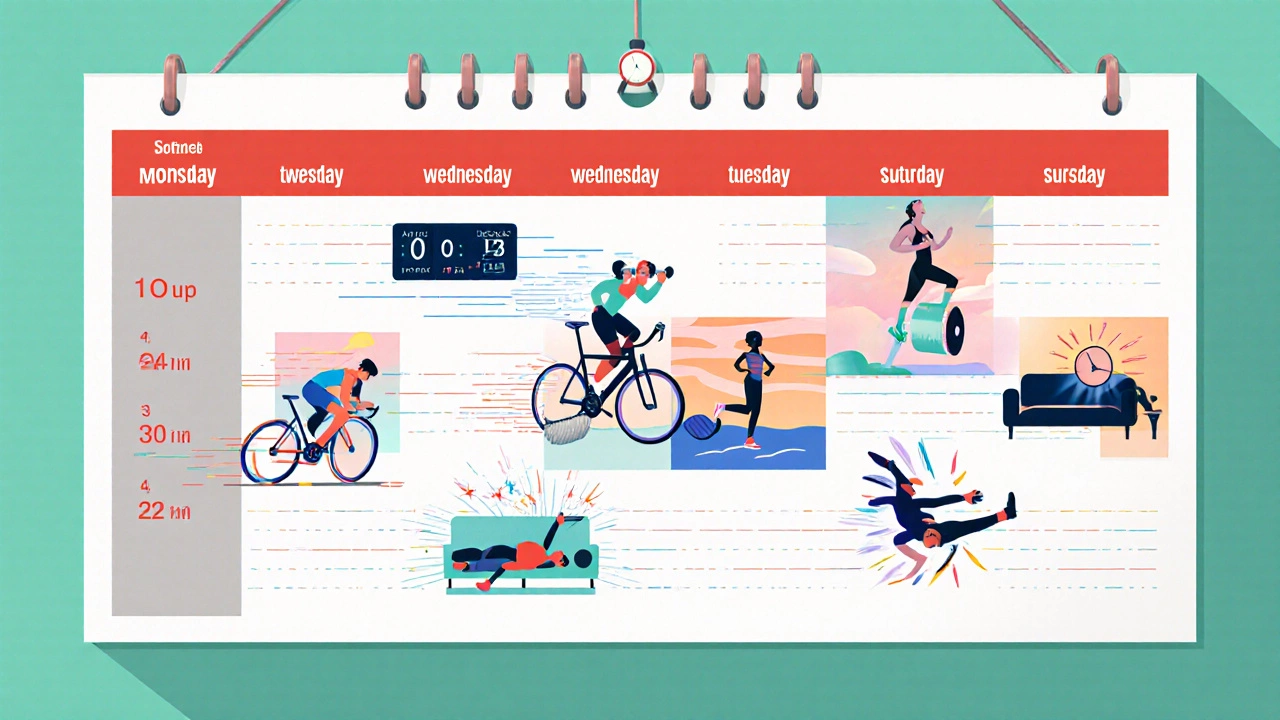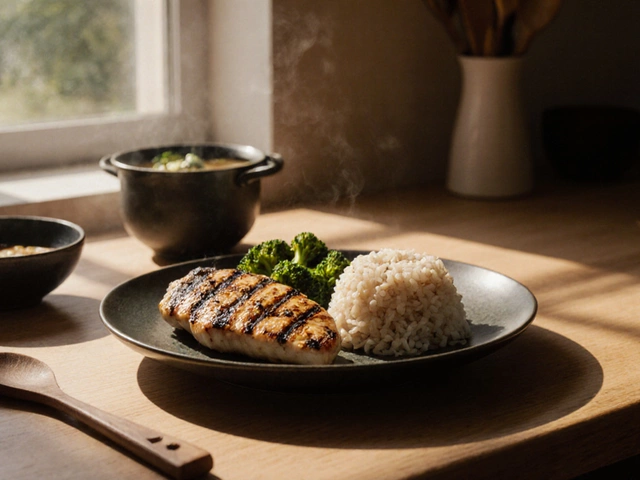4-Week Toning Progress Tracker
Expected Changes After 4 Weeks
Key Insights:
Quick Takeaways
- Significant visible change in 4 weeks is possible, but true "toning" needs body‑fat loss + muscle gain.
- Combine strength training, HIIT, adequate protein, and proper recovery.
- Track progress with measurements, not just the scale.
- Stay consistent: 4‑5 sessions per week, 45‑60 minutes each.
- Expect a 0.5‑1% body‑fat reduction and 1‑2kg of lean muscle in a month if you follow the plan.
When you hear the phrase muscle toning, you might picture a quick fix or a magic pill. In truth, tone up means lowering body‑fat while building or preserving muscle so the shape of your body becomes more defined. The question isn’t "can you magically sculpt a six‑pack in a month?" but "can you set up the right conditions to see noticeable tightening in four weeks?" This article breaks down the science, the training blueprint, nutrition tweaks, and the mindset you need to make those four weeks count.
Why Four Weeks Can Show Real Change
Four weeks isn’t a long enough window to completely transform your physique, but it is sufficient to trigger measurable adaptations:
- Progressive overload - increasing load or volume forces muscles to adapt, and noticeable strength gains can appear in as little as 10‑14 days.
- High‑Intensity Interval Training (HIIT) boosts metabolic rate for up to 48 hours post‑session, accelerating fat loss.
- Consistent protein intake (around 1.6‑2.2g per kilogram of body weight) fuels muscle repair and growth, helping you preserve lean tissue while in a slight caloric deficit.
These three pillars-strength, cardio, nutrition-work together to shift the body‑composition ratio in a short period.

Step‑by‑Step 4‑Week Toning Blueprint
Below is a weekly schedule you can copy‑paste into a planner. Adjust the weights to match your current strength level, but keep the structure intact.
- Monday - Full‑Body Strength
- Squats - 3×8‑10reps
- Bench Press - 3×8‑10
- Bent‑Over Rows - 3×8‑10
- Plank - 3×45seconds
- Tuesday - HIIT + Core
- 30‑second sprint on bike or treadmill, 30‑second rest × 10 rounds
- Russian Twists - 3×20
- Leg Raises - 3×15
- Wednesday - Active Recovery
- Light jog or brisk walk 20‑30min
- Foam rolling + dynamic stretching
- Thursday - Upper‑Body Focus
- Pull‑Ups (assisted if needed) - 3×max
- Overhead Press - 3×8‑10
- Incline Dumbbell Press - 3×10‑12
- Side Plank - 3×30seconds each side
- Friday - Lower‑Body & HIIT
- Deadlifts - 3×8‑10
- Lunges - 3×12each leg
- Burpees - 4×30seconds work, 30seconds rest
- Saturday - Mobility + Light Cardio
- Yoga flow 30min (focus on hips and shoulders)
- Easy bike ride 15‑20min
- Sunday - Rest
Complete rest, hydrate, and get 7‑9hours of sleep.
This schedule hits each major muscle group twice, layers in HIIT for fat burn, and respects recovery. If you’re a total beginner, replace some lifts with bodyweight alternatives (e.g., push‑ups instead of bench press) and keep the intensity moderate.
Nutrition Blueprint for a 4‑Week Tone‑Up
Exercise alone won’t reveal muscle definition if the diet is off. Follow these three nutrition rules:
- Caloric Deficit: Aim for 200‑300kcal below maintenance. That’s enough to shed ~0.5% body‑fat per week without sacrificing muscle.
- Protein Priority: Protein intake of 1.8‑2.2g per kilogram of body weight spreads across 4‑5 meals keeps muscle‑protein synthesis active.
- Balanced Carbs & Fats: Choose complex carbs (sweet potatoes, oats, quinoa) for energy during workouts and healthy fats (olive oil, nuts, avocado) for hormone health.
Sample day (2000kcal target):
- Breakfast: 3egg whites + 1 whole egg, spinach, ½ cup oats (30g protein)
- Snack: Greek yogurt + berries (15g protein)
- Lunch: Grilled chicken breast 150g, quinoa ¾ cup, mixed veg (35g protein)
- Pre‑workout: Banana + 20g whey isolate (20g protein)
- Dinner: Baked salmon 120g, sweet potato, broccoli (30g protein)
Hydration matters, too-aim for 2‑3L of water daily to support metabolism and muscle recovery.
Key Factors That Influence How Fast You’ll See Results
Everyone’s body responds differently. Here are the variables that will either speed up or slow down your progress:
| Factor | Positive Influence | Negative Influence |
|---|---|---|
| Training Frequency | 4‑5 sessions/week provides enough stimulus | Less than 3 sessions leads to slower adaptations |
| Sleep Quality | 7‑9hrs boosts hormone balance and recovery | Under 6hrs impairs muscle repair |
| Stress Levels | Low chronic stress keeps cortisol in check | High stress raises cortisol, storing fat around the midsection |
| Nutrition Consistency | Steady protein & calorie tracking fuels growth | Frequent cheat meals create calorie spikes |
Notice how each factor is a lever you can pull. If you’re lagging, pinpoint the biggest negative and fix it first.
Common Pitfalls & How to Dodge Them
- Relying Solely on Cardio: Cardio burns calories but doesn’t preserve muscle. Pair it with strength work.
- Skipping Warm‑Up: A 5‑minute dynamic warm‑up prepares joints and reduces injury risk, keeping you on track.
- Ignoring Progress Metrics: The scale can be misleading. Use body‑fat measurements, progress photos, and strength logs.
- Over‑training: More isn’t always better. If you feel sore for days, add an extra recovery day.
- Undervaluing Protein: Below 1.5g/kg, the body may break down muscle to meet needs, undoing your hard work.
What to Expect After the First Four Weeks
With strict adherence, most people report:
- 1‑2kg (2‑4lb) of lean muscle gain or preservation.
- 0.5‑1% reduction in body‑fat, which often translates to a visibly tighter midsection.
- Increased strength: lifts may be 10‑15% heavier.
- Better energy levels and posture thanks to core strengthening.
Remember, the visual “toned” look also depends on genetics-where you store fat and how your muscles are shaped. The plan gives you the best possible edge, but individual results will vary.
Frequently Asked Questions
Can I see abs after just four weeks?
If your body‑fat percentage is already near 12‑14% for men or 20‑22% for women, a four‑week routine can reveal the underlying abs. For higher body‑fat levels, you’ll notice tighter hips and thighs first, with a visible six‑pack taking longer.
Do I need supplements to tone up quickly?
Supplements aren’t mandatory. A high‑quality whey protein can help meet protein targets, and creatine monohydrate can boost strength. Stick to whole foods first; supplements are just a convenience.
How much cardio is too much?
Aim for 2‑3 HIIT sessions per week, each no longer than 20 minutes, plus light active‑recovery days. Exceeding 5‑6 high‑intensity cardio sessions can start eating into muscle‑building capacity.
What if I can’t train five days a week?
Trim the program to three full‑body strength days with a short HIIT finisher. Consistency beats quantity-make sure each session is focused and progressive.
Should I track calories or just eat clean?
Tracking calories for the first two weeks helps you find the right deficit. After that, you can switch to a “clean‑plate” approach while still watching portion sizes.
Is a four‑week plan enough to build lasting habits?
Yes. A month of consistent scheduling, meal prep, and sleep hygiene often cements routines that stick beyond the program. Use the 4‑week cycle as a habit‑building sprint.
Bottom line: You can absolutely see a tighter, more defined look in four weeks, as long as you combine strength work, smart cardio, adequate protein, and recovery. Treat the month as a focused sprint, then transition into a longer‑term maintenance plan to keep the gains coming.





